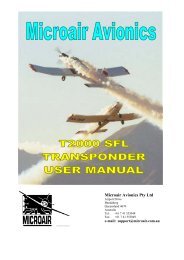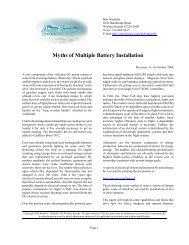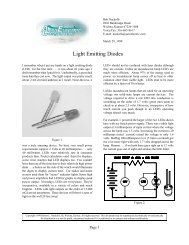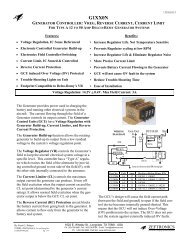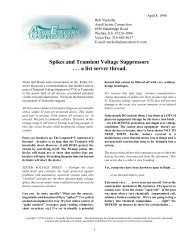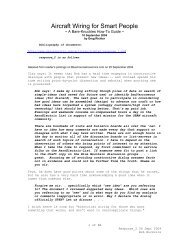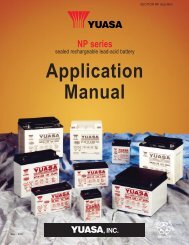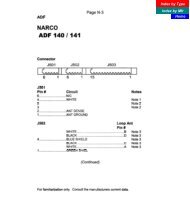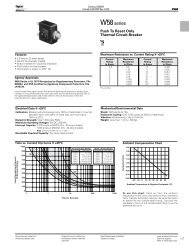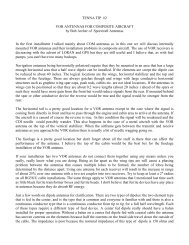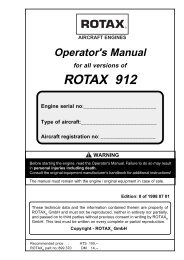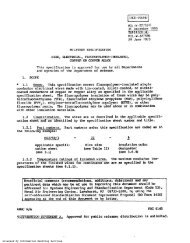A Belated Tribute to my most cherished teacher.
A Belated Tribute to my most cherished teacher.
A Belated Tribute to my most cherished teacher.
You also want an ePaper? Increase the reach of your titles
YUMPU automatically turns print PDFs into web optimized ePapers that Google loves.
Things I would liked <strong>to</strong> have sharedwith <strong>my</strong> <strong>most</strong> valued <strong>teacher</strong>Bob Nuckollscirca 1992Dear Blondina,I am saddened <strong>to</strong> read that so much sorrow has visited you; all at one time<strong>to</strong>o. When I was writing the letter <strong>to</strong> begin a search for your new home, I knewthat it had been much, much <strong>to</strong>o long since I had been in contact. Your newswas very sad and affected me greatly. It has taken some time <strong>to</strong> gather up awherewithal <strong>to</strong> reply. There are many things I would have shared with Ed. I'lltry <strong>to</strong> assuage some of <strong>my</strong> personal recriminations by sharing with you.You may recall, I met Ed (like many other hams in our neighborhood, cruisingthe streets on a bike and being mindful of antennas and license plates. Ithink I was still in the 6th grade at Allen school when I first knocked onyour door. I don't know how much of teenaged years family life you werepersonally aware of.My folks were divorced shortly after we moved in<strong>to</strong> the house on southRidgewood. Their marriage suffered badly as a consequence of <strong>my</strong> mother'sschizophrenia. I did not have the benefit of contact with <strong>my</strong> father for nearly7 years after their divorce. Ed proved <strong>to</strong> be like no other adult I knew. I amunable <strong>to</strong> describe the difference in terms I would have used then. Today Iknow that he was as close <strong>to</strong> a father as I would have for the next six years.In many respects, he was better than <strong>my</strong> own father could have been. He hadsuperior skills and knowledge in a discipline that was significant <strong>to</strong> me butmore importantly, Ed was a <strong>teacher</strong> in the <strong>most</strong> practical and honorable senseof the word.All the way through junior and senior high school, Ed shared generously of histime, skills and knowledge. Those commodities were valuable but it was manyyears later that I became aware of another gift from Ed Fis<strong>to</strong>r. It had <strong>to</strong> dowith the way Ed shared of himself. He could be very demanding in what heexpected of me but without being demeaning or making me feel inadequate.Conquering ignorance was simply a matter of building on what one already knew.That was his unique method of teaching. I don't think Ed ever directlyanswered a question. I learned <strong>to</strong> expect a follow-on series of questions. Hewould make me explore everything I already knew as foundation for the answer.Often, as a result of this process, I would answer the original question for<strong>my</strong>self. His <strong>most</strong> important gift <strong>to</strong> me was an attitude. A way of thinking andworking with people <strong>to</strong> make the <strong>most</strong> of what they already possess and <strong>to</strong> makethem believe in what they could accomplish.(As I write this, I am on an airplane bound for Los Angeles. I am <strong>to</strong> meet withsome at<strong>to</strong>rneys who are defending a railroad being sued for the results of aserious accident. At<strong>to</strong>rney's are well versed in the dogma of their <strong>teacher</strong>sand as a class of professionals I find them especially lacking in creativity.It is al<strong>most</strong> as if the "law", as it was taught <strong>to</strong> them, has cast their actionsand thinking in<strong>to</strong> s<strong>to</strong>ne. My task is <strong>to</strong> help them mount their defense ontechnical grounds which they do not understand. I will be relying heavily uponthe Fis<strong>to</strong>r technique <strong>to</strong> help them define and perform their task.)I recall during our last meeting in California, telling you how startling itwas <strong>to</strong> see Ed again after so many years. It was al<strong>most</strong> eerie how much of Ed Icould see in <strong>my</strong>self. His mannerisms and some forms of speech were like lookingin<strong>to</strong> a mirror. I hadn't realized until then how much of him had become a par<strong>to</strong>f me. I recall his disappointment in the fact that I did not finish college.
I don't know if "disappointment" is exactly the right word <strong>to</strong> describe hisreaction. It is difficult <strong>to</strong> describe what transpired in that brief exchange.We were sitting at the table in your kitchen and I was bringing him up <strong>to</strong> dateon <strong>my</strong> activities since you'd moved <strong>to</strong> California. I don't remember his wordsso much as the feelings behind the words. For <strong>my</strong> own part I was feeling likethe kid being confronted by a loving grandparent for some serious breach ofpromise. There's not another person on the face of this earth who could makeme feel that way.I don't know if a degree would have made a great deal of difference in <strong>my</strong>present condition. Wichita general aviation industries are unique in a waythat was beneficial <strong>to</strong> me. When I was heavily involved in the aviationindustry, engineering departments still echoed with the footsteps of WalterBeech, Clyde Cessna, Duane Wallace, Bill Lear and the like. There were "oldtimers" in those rooms who had wonderful s<strong>to</strong>ries <strong>to</strong> tell about the earlybeginnings of aviation in Wichita. Most interesting were s<strong>to</strong>ries of a designerbecoming suddenly aware of someone looking over their shoulder. It might havebeen Bill, Clyde or Walter who would be checking in<strong>to</strong> how-goes-it. They mightleave without saying a word. Or, they could just as easily completely revisethe work in progress, much <strong>to</strong> the consternation of the "victim". The uniquefeature was a patriarchal interest and participation at all levels of thecorporate experience, especially in the creative effort.When I began <strong>to</strong> pursue a profession, engineering departments in local plantsstill operated with an attitude, "If you can do the work, you can have thejob." They were more interested in results than an ability <strong>to</strong> attend classesand pass tests. Wichita was big enough <strong>to</strong> have these industries but smallenough <strong>to</strong> permit one <strong>to</strong> build a reputation. Corporate competition aside,everyone was familiar with the who's who of aviation. This resulted in <strong>my</strong>being able <strong>to</strong> work for all the aircraft plants and a major supplier <strong>to</strong> theaircraft industry in an engineering capacity. My last position with generalaviation was with Gates-Lear jet where I was supervisor of theelectrical/avionics group for design of a <strong>to</strong>tally new airplane.To say that <strong>my</strong> association with Ed was responsible for <strong>my</strong> successes might bestretching a rational evaluation of cause and effect. It is certain that Edmade a major contribution in showing me an approach <strong>to</strong> problem solving. Fewgood ideas are flashes of pure inspiration. Practical, if not elegantsolutions are evolutionary progressions based upon what is already known.Step one in any task: review what you (and your colleagues) already know andbuild on that. Ed taught me how <strong>to</strong> do that.When I last saw you I was married then some 11 years. I was raising two sonsby Melissa whom I met after graduating from high school and while working atBoeing. When Boeing laid me off in the fall of '62, Ed helped me get a jobteaching electronics with the industrial education department at theUniversity of Wichita. It was there I discovered the joy of teaching. It wasalso gratifying that former supervisors from Boeing (who undoubtedlyconsidered Bob Nuckolls <strong>to</strong> be a smart-assed, wet nosed kid) turned up in someof <strong>my</strong> classes. That job could have been <strong>my</strong> ticket <strong>to</strong> a degree. I was workingon campus, taking classes on one side of the street and teaching classes onthe other. Had that situation held for a couple of years, I suspect that Iwould have finished. Early on, the courses I taught were changed fromadult continuing education classes <strong>to</strong> college credit courses. I was demotedfrom instruc<strong>to</strong>r at $600/semester/class <strong>to</strong> "teaching assistant" for $1.50/hour.An income of about $50/week wouldn’t support me <strong>to</strong> stay in school. I had lefthome just prior <strong>to</strong> getting the job at W.U., <strong>my</strong> mother's illness had becomemore than I could deal with <strong>to</strong>o.At the invitation of <strong>my</strong> future father-in-law, I moved <strong>to</strong> Tucson and lived withhim while getting established there. I got an excellent job at Hughes Aircraft
as an electronic technician. This was the first job where <strong>my</strong> graduation fromthe Fis<strong>to</strong>r school of problem solving really paid off. The job prerequisites inthe newspaper ad sorely missed the mark. People who just met the requisiteswould have a difficult time. My task was <strong>to</strong> put first- power on components ofguided missiles which were manufactured there. If the device didn't work, Iwas <strong>to</strong> trouble shoot it and send it back <strong>to</strong> the assembly line for replacemen<strong>to</strong>f parts. I worked second shift and it was pretty quiet. Only a dozen of thefifty or so work stations were occupied then. One night <strong>my</strong> supervisor calledme in<strong>to</strong> his office and I was shown a big chart on his wall which compared"productivity" of the various work stations on other shifts that were alsodoing <strong>my</strong> job.He pointed out the column for "Completed Units" and queried me as <strong>to</strong> why <strong>my</strong>little box had numbers like 3, 7, 4 and other shifts had 20, 32, and 19. I<strong>to</strong>ok him out <strong>to</strong> <strong>my</strong> work station and showed him the stack of modules that didnot work. These had been put aside by opera<strong>to</strong>rs on other shifts. Presumablythey would get back <strong>to</strong> them when they ran out of modules that required no repairs. As a result, their numbers for completed work were impressive. I spent<strong>most</strong> of <strong>my</strong> time diagnosing problems and ordering repairs on the units theywouldn't or couldn't fix. My boss just nodded his head and said, "drive on.""If anyone bugs you about the numbers again, just tell them <strong>to</strong> talk <strong>to</strong> me."Nobody ever did . . . .While living in Tucson, Melissa and I got married. I worked at Hughes untilbeing laid off at about 9 months. We joined Melissa's folks again, this timein Pittsburgh, PA. I found a job with a little company in Apollo, PA, calledNUMEC. They manufactured nuclear fuel rods for reac<strong>to</strong>rs. I was very fortunatein that I was hired <strong>to</strong> work for a very talented and intelligent engineer whowas also a bit eccentric. I don't think he was an employee of NUMEC but acontract consultant. He had several other jobs in the area and I would see himfor only a few hours a week. We never conducted business in the plant. Hewould show up about 10 in the morning and hustle me and <strong>my</strong> notebook off <strong>to</strong> therestaurant across the street. There, much <strong>to</strong> the chagrin of the owner, hewould spread drawings out on several tables and order only coffee for two. Wewere al<strong>most</strong> literally thrown out of the place when we occupied this space <strong>to</strong>oclose <strong>to</strong> the lunch hour!Ed would have approved of Len Walak as supervisor <strong>to</strong> a young electronicsfreak. Len would always ask what I thought was a good approach <strong>to</strong> a problem. Idon't know if he really couldn't think of a better way but more often thannot, he would let me try <strong>my</strong> idea first. Maybe he was just a bit lazy. Whateverhis motives, he provided me with an environment <strong>to</strong> develop and build creativeskills. When faced with a decision without benefit of his guidance, he neverdisapproved of me trying something on <strong>my</strong> own. As a result, the stuff we builtwere as much <strong>my</strong> creation as they were Len's. Shortly after JFK was killed, thefac<strong>to</strong>ry side of the plant went on strike. The door <strong>to</strong> <strong>my</strong> workplace was being"picketed" (guarded is the more appropriate term) by a very big guy with asign on a big stick. Melissa and I packed up and headed back <strong>to</strong> Wichita. Iwould have liked <strong>to</strong> work for Len further; he was very instrumental in lettingme explore <strong>my</strong> own capabilities.Melissa was pregnant with our first child and we rented a small apartment oneast Central. I found a job with Graham Two-Way in El Dorado. The job onlypaid $1.25/hour plus a gasoline allowance for commuting. We worked a 58 hourwork week plus double time for work on <strong>to</strong>wers over 50-feet off the ground.Needless <strong>to</strong> say I was their <strong>most</strong> enthusiastic volunteer for <strong>to</strong>wer work! Ourfirst baby, a girl, was victim of a tangled umbilical and lived only a fewhours after birth. Melissa was devastated and I really needed <strong>to</strong> upgrade <strong>my</strong>job so we could move out of the little apartment. I was on <strong>my</strong> way <strong>to</strong> a jobinterview with Cessna when I s<strong>to</strong>pped <strong>to</strong> look in<strong>to</strong> a newspaper ad looking for
<strong>teacher</strong>s. The ad was placed by a head-hunter outfit looking for contractinstruc<strong>to</strong>rs at Great Lakes Naval Training Base near Chicago. I never made i<strong>to</strong>ut <strong>to</strong> Cessna. A few days later, Melissa and I packed virtually everything weowned in<strong>to</strong> a '59 Chevy and a small trailer (the trailer was full ofelectronics parts! Living stuff had <strong>to</strong> fit in<strong>to</strong> the car . . . you probablyunderstand how those priorities worked!).The teaching job at Great Lakes was more fun than work. The school in which Iworked ran fourteen two-week segments which taught basic electronics. Most ofthe students were recruits; some were individuals who re-enlisted <strong>to</strong> takeadvantage of the Navy's excellent schools. It was an ideal teaching situation,all military rank disappeared at the classroom door and the students wereconstantly reminded that learning was their sole purpose for being there.While the curriculum was quite good, the school's management did have a basicflaw. Students were tested every Friday afternoon on the previous week's work.The tests were multiple choice chosen from a large bank of questions at thetesting center. As large as the bank was, it did not take long for instruc<strong>to</strong>rs<strong>to</strong> learn the test material. A trap for many instruc<strong>to</strong>rs was that they beganteaching <strong>to</strong> the tests. The problem was exacerbated by a practice of lettingthe high score class for each section (and their instruc<strong>to</strong>r) off early onFriday right after tests were scored. The other students didn't get weekend"shore leave" until 6 or 7 that evening.I taught in the upper four segments of the course. I had been there forseveral months and really felt like I was doing a pretty good job. One Mondaymorning, an older Navy Chief (who re-enlisted for the schooling and betterpay) hit me up for <strong>my</strong> "poor performance" as an instruc<strong>to</strong>r. I wasflabbergasted. I'd really never thought about it much but he pointed out thatI never had made high class for a Friday exam. It <strong>to</strong>ok only seconds for me <strong>to</strong>formulate the response. The Ed Fis<strong>to</strong>r in me rose up and said, "My friend, <strong>my</strong>job is not <strong>to</strong> teach you how <strong>to</strong> pass a test. That's your problem. My job is <strong>to</strong>teach electronics. If you pay attention <strong>to</strong> what's going on up here and hit thebooks when you are not here, you're career in electronics will benefitwhether or not these people hit the taverns early next Friday."It was a good thing that Navy policy gave such power <strong>to</strong> instruc<strong>to</strong>rs, I was 22years old and that Chief was a 10 year veteran of the Navy. I found later that<strong>my</strong> "reputation" was so pervasive that classes coming up had me pegged as the<strong>most</strong> undesirable of instruc<strong>to</strong>rs, which suited me just fine. I renewed <strong>my</strong>resolve not <strong>to</strong> teach <strong>to</strong> the tests . . . in spite of the fact that I couldhear instruc<strong>to</strong>rs across the hall doing just that. I would have stayed longer,I truly enjoyed teaching. I just couldn't live on $90/week and pay $195/monthrent on a barely livable apartment. The last Friday I taught there, just hoursbefore I was <strong>to</strong> depart for Wichita, <strong>my</strong> class nailed high score in the section.Melissa and I headed for home a few hours earlier. That Chief was long gonefrom the base but I sure would have liked show him that I knew from where Ispoke.Amazingly enough, that job I was going out <strong>to</strong> interview for at Cessna somemonths earlier was still open! I went <strong>to</strong> work as a technical writer forproduction of kits and instructions on field installations of radios. There Ilearned <strong>to</strong> illustrate, a skill which still serves me well. I also learned <strong>to</strong>organize thoughts and put them on paper. My design skills were applied there<strong>to</strong>o but not in the handbooks department. The electrical design group was rightacross the isle from me and I probably spent a third of <strong>my</strong> time over there,participating in design discussions. After more than four years, I had worked<strong>my</strong> way up <strong>to</strong> salary and I was beginning <strong>to</strong> feel the pressures of not learninganything new at <strong>my</strong> job. I asked for a transfer <strong>to</strong> the design group. The supervisor was willing but he wanted <strong>to</strong> bust me back <strong>to</strong> grade 3 hourly. Hisrational was that I didn't have any experience at the job! Little did he know. . . .
While at Cessna, another fortui<strong>to</strong>us chain of events <strong>to</strong>ok place. The chief offlight test was partners with another man in the ownership of what was alreadya classic, if not antique, air plane. He had purchased a surplus radio fromCessna and was asking around for someone <strong>to</strong> install it. The airplane was a1954 model 195, all the mechanics around then were familiar with 1968 models.Bill could find no one who was eager <strong>to</strong> do the installation in his "old"airplane. My job for the past four years had been <strong>to</strong> research drawings onolder airplanes and architecture installation kits. I <strong>to</strong>ld Bill I'd be glad <strong>to</strong>do his installation.While laying on <strong>my</strong> back in the grass, drilling holes in the belly skin of the195, a car pulled up in front of the airplane and the driver got out. I s<strong>to</strong>odup <strong>to</strong> meet him and the stranger introduced himself at Ken Razak, second halfof the partnership in the airplane. Ken Razak had been dean of engineering atW.U. while I was still a student there. I had been in his office for paperwork and knew who he was but I'd never met him. It didn't take Ken long <strong>to</strong>find out who Bob Nuckolls was, where he was going and how he thought he wasgoing <strong>to</strong> get there! Some weeks later, Ken called me on the phone. He said hewas working on a piece of hospital equipment which would require a ratherextensive electrical system. He asked if I would like <strong>to</strong> do the design work onit. Ken was <strong>my</strong> first consulting cus<strong>to</strong>mer while I was still working at Cessnalate in 1968. Later in '69, after being turned down for transfer <strong>to</strong> the designgroup at Cessna, I left <strong>to</strong> work full time with Ken on the Mobilizer. A veryunique and capable piece of patient handling equipment.I worked as a consultant <strong>most</strong>ly <strong>to</strong> Ken but I picked up a few short term jobswith other clients over the next two years. One of those clients was a companywho needed a new security system designed for a central station burglar andfire alarm company. This was a job that gave me a good lesson in financialmanagement. I was <strong>to</strong> receive progress payments on the task and I had committed<strong>my</strong> personal credit <strong>to</strong> procurement of materials for their job. One day abouthalf way through the project, I went <strong>to</strong> their office <strong>to</strong> pick up a check andfound it cleaned out. They had gone bankrupt. Most of the stuff I hadcommitted for was not returnable; I was right behind them in filing forbankruptcy.By this time I had two sons, Eric (1965) and Scott (1968). One of <strong>my</strong>consulting cus<strong>to</strong>mers, ElectroMech, Inc., offered me a full time job and I <strong>to</strong>okit. The job entailed design and development of cus<strong>to</strong>m electronics products forthe local aircraft industry. My interviews with Fred Coslett, owner ofElectroMech, suggested that I target "Chief Engineer" as a job goal. This wasthe first time that I was really able <strong>to</strong> expand <strong>my</strong> skills as a designer.The job with ElectroMech went quite well for several years. One day, withoutwarning, a new face showed up in ElectroMech's engineering department. The manwas formerly an engineer with Cessna and I had worked with him briefly onseveral projects in the past. About two weeks after Pete showed up, Fredannounced that Pete was <strong>to</strong> be our new "chief engineer." I was surprised butnot terribly hurt. I don't think Fred even remembered our conversations ofsome years earlier. I reasoned that it was just possible I could learnsomething from Pete . . . he did have many years experience at Cessna.Over the next year we determined that Pete had little technical skills <strong>to</strong>contribute. His management style was somewhere between lord of a medievalserfdom and prison warden. For the <strong>most</strong> part, he became the butt of many jokesamongst his staff and <strong>most</strong> of the plant that had any contact with him. When hemade a big deal of announcing upcoming performance interviews with theengineering staff, we were all somewhat amused with idea that he couldrealistically evaluate any of us!It <strong>to</strong>ok him a whole day <strong>to</strong> "evaluate" the first two victims and half of asecond day for the third. I was <strong>to</strong> be last. I had the advantage of knowing
what <strong>to</strong> expect after having talked with <strong>my</strong> colleagues beforehand. Histechnique was <strong>to</strong> be especially demeaning before finally giving a raise. Healso instituted some especially tight rules about taking personal briefcasesin and out of the plant. He alluded <strong>to</strong> some "missing" drawings and otherdocuments. My interview lasted fifteen minutes. I called his bluff on somepoor performance issues he raised. I deeply resented being suspected a thiefand <strong>to</strong>ld him I needed <strong>my</strong> brief case <strong>to</strong> carry books and <strong>to</strong>ols between home,school and work. However, he could feel free <strong>to</strong> inspect <strong>my</strong> briefcase at anytime, with or without <strong>my</strong> specific permission. He gave me the raise andterminated the interview. The briefcase rules were rescinded next day. Thefollowing week I began <strong>to</strong> look for another job.The next job was with the owners of television channel 3. The company wasKansas State Network (KSN). I was supposed <strong>to</strong> be a production manager but thechief engineer for the job sort of lost interest after he'd seen the productwork the first time. It had a lot of producibility and reliability problems. Ireceived what was <strong>to</strong> be a crash course in video design and spent nearly twoand a half years upgrading the product. That was the job I held when I saw youlast in Sunnyvale. KSN folded in spite of our engineering and productionefforts. Our division manager turned out <strong>to</strong> be pretty inept. He was son-in-law<strong>to</strong> chairman of the board . . . being groomed for greater things in futureyears. Too bad he couldn't manage better. I Guess KSN got off lucky. It wasbest <strong>to</strong> find out how bad he was and cut their losses at 2 million dollars!Given bigger responsibilities he might have really hurt them!After KSN folded, I began <strong>to</strong> do consulting work again. A fallout of the KSNdebacle left me with a ready made clientele for video work. We had built about400 time base correc<strong>to</strong>rs and I was the sole source for repairs and updatesafter KSN went out of business. I <strong>to</strong>ok a consulting job with a company inLawrence, Kansas and would live every other week in Lawrence. Ken Razakcontinued <strong>to</strong> be an occasional but steady source of project work in hisaccident investigation, analysis and expert witness practice.Over the next three years, Pete finally showed all of his true colors atElectroMech and was dismissed by Fred. Fred also hired me as a consultant <strong>to</strong>do a few small jobs. He later made a full time offer which I accepted.ElectroMech had done rather well for itself in spite of Pete's ineptitude anddishonesty. I was <strong>to</strong> become involved in a number of big projects for ElectroMech. One product was retrofitted <strong>to</strong> the entire fleet of LearJets in answer <strong>to</strong>an FAA airworthiness directive. That project got me a fat raise and freeflying lessons! All <strong>to</strong>taled, I worked at ElectroMech for over 7 years.About 1982, <strong>my</strong> kids were nearly grown and Melissa had finished her mastersdegree in sociology. Our personal and professional lives had been divergingfor over ten years and we decided <strong>to</strong> get divorced just days before our 20thanniversary. She moved <strong>to</strong> Lawrence <strong>to</strong> teach and pursue a PhD. Both sons workedin the Wichita area for a time after graduation. They both went througha <strong>to</strong>ugh time of adjusting <strong>to</strong> the responsibilities of providing for themselves.Scott is now married. His mother-in-law is a professor at KU in the biologydepartment; the father is an M.D. in student health services. Both Scott andKathleen (his wife) are studying at K.U. Eric has a live-in intended. They arebuying a mobile home near Lawrence and have made plans for a wedding nextJune.About that time <strong>my</strong> brother Tim was planning a trip <strong>to</strong> New Mexico. He was <strong>to</strong> befeatured in an art show in Santa Fe and appear in person on a Friday nightbefore Labor Day. He didn't have the money <strong>to</strong> travel <strong>to</strong> Santa Fe. I was alsoshort of cash but I did have a generous flight proficiency budget fromElectroMech so I offered <strong>to</strong> fly him there for the weekend. We sat aroundtalking about what <strong>to</strong> do with the rest of the weekend (he only needed <strong>to</strong>be there Friday night), without spending much money. We decided <strong>to</strong> take the
airplane's rear seat out and pack our bicycles. We planned <strong>to</strong> fly <strong>to</strong> AngelFire in the mountains east of Taos, cycle around there for the rest of theweekend and camp out. It had been years since I'd ridden a bike for longdistances much less at 8500 feet! I began training for the trip by riding <strong>my</strong>bike about 15 miles a night after work.I began <strong>to</strong> s<strong>to</strong>p every evening, a short distance from home at a conveniences<strong>to</strong>re <strong>to</strong> drink an orange juice <strong>to</strong> cool down. For <strong>most</strong> of <strong>my</strong> visits, lady namedDeanna was clerking. We became acquainted over the weeks I was preparing forthe trip. I didn't ride the bike any more that year after the trip. Nextspring, just for fun, I dug the bike out and went for a ride I s<strong>to</strong>pped at thes<strong>to</strong>re again and Dee was still working there. She remembered me from theprevious fall and asked about the trip. One thought led <strong>to</strong> another and Iinvited her <strong>to</strong> go flying. I really wasn't looking <strong>to</strong> get married again but Iwas very taken with the lady's personality and intelligence. She was justbecoming divorced herself and had a 2-year old boy by that marriage. His nameis Zachary. A few weeks later we flew <strong>to</strong> Santa Fe for a weekend and I think Ifell in love with her there. I asked Dee <strong>to</strong> marry me the next Christmasmorning. One year later, on Christmas day, and we were indeed married.My job at ElectroMech was beginning <strong>to</strong> stagnate and Gates-Lear jet had strucka partnership with an Italian firm <strong>to</strong> design and build a rather revolutionaryturbo-prop airplane. This was the first time in over twenty years that aWichita firm started a new model design from a clean piece of paper! I talkedwith some of <strong>my</strong> contacts at Lear and was hired in<strong>to</strong> the electrical/avionicsgroup for the new GP-180.My supervisor was a long time acquaintance and former cus<strong>to</strong>mer of ElectroMech.He was a capable engineer but a weak manager. About a year in<strong>to</strong> the program, Iwas promoted <strong>to</strong> supervisor of the group. My shot at the GP-180 was hauled upshort when Lear jet got in<strong>to</strong> money troubles on the jet side of the house. Theyelected <strong>to</strong> bail out of the GP-180. They offered me a job on the jet side but Ijust couldn't get very excited about those air planes. I put out some feelersagain and was offered a position with Beech's Missile Systems Division. Beechwas cultivating a partnership with Martin, Sperry, Ball Aerospace andSinger-Kearfott on a remotely piloted reconnaissance airplane. This was much<strong>to</strong> <strong>my</strong> liking, I've never been very comfortable working on "people-killing"machines. I wore two hats there, one as assistant <strong>to</strong> the project manager forcoordination of electrical/avionics issues between the partners (got <strong>to</strong> travela lot!) and as a design engineer on a portion of Beech's systems.Beech wrote a pretty good proposal but our choice of Martin as primecontrac<strong>to</strong>r proved <strong>to</strong> be a poor one. The group of "engineers" I was workingunder at Martin all held PhD's. Everyone was addressed as "doc<strong>to</strong>r." Never in<strong>my</strong> life have I met such an incapable collection of people. They couldn't evenproduce a credible outline for our proposal documents much less write them. Iam certain that they were equally incapable of designing functional systems.My engineering boss and I spent days in Baltimore proof reading andreorganizing their proposal text on the electrical/avionics systems. When Ireceived a copy of the final proposal I was dumbfounded. There were majorportions of the document I couldn't understand and I was supposed <strong>to</strong> behelping design the thing. The Navy said we lost the bid on price. I think theywere being kind. I think they must have given up in disgust. I don't thinkanyone figured out what kind of machine we were offering <strong>to</strong> build!Since <strong>my</strong> serendipi<strong>to</strong>us meeting with Ken Razak some 24 years ago, I have beenprivileged <strong>to</strong> work with him in support of his accident analysis and experttestimony. Until three years ago, I was a consultant <strong>to</strong> him but when the Beechexperience began <strong>to</strong> sour we began <strong>to</strong> discuss a new business. It is difficulttasks for any witness (and examining at<strong>to</strong>rney) impart a common images inminds jurors as <strong>to</strong> the facts of their testimony. It is especially difficult <strong>to</strong>
produce a sense of timing. Ken has testified in over 1000 cases and providedexpert services in perhaps 7000 more. His understanding of this problem isquite unique. About four years ago we began <strong>to</strong> develop a technique forproducing video animations of accidents <strong>to</strong> illustrate witness testimony incourt. A number of our contemporaries are doing similar work usingcomputers for image development and depiction of motion. Ken rightfullyperceived a difficulty in getting courts <strong>to</strong> admit computer imagery; it is <strong>to</strong>o"car<strong>to</strong>onish." Further, motions depicted are controlled by "closed" softwarewhich cannot be cross examined. Our approach moves vehicles on scale modelsusing computers for which we wrote our own software. Computers areheavily utilized in our business but in ordinary support capacities ascomputational aids. All software used <strong>to</strong> portray vehicle motions is generatedin house and open <strong>to</strong> cross-examination. Our scenes are very realistic; clientsand eye-witnesses often have trouble distinguishing our studio scenes fromthose shot on site.The business has done well and returned all original investment plus a niceprofit <strong>to</strong> Ken in under three years since incorporation. In anticipation of hisretirement, Ken set up Videmation, Incorporated, as a separate entity fromRazak Engineering, Inc. Razak Engineering has been Videmation's biggestclient. Ken is not going <strong>to</strong> take any new cases after this year (he is 74 thissummer!) and our big goal for the year is <strong>to</strong> widen our client base and standVidemation up on it's own feet. My trip this week was <strong>to</strong> L.A. on a pedestrianaccident at a railway depot in San Juan Capistrano. The firm representingAmtrak in this case is a very large one with offices in several major cities.The at<strong>to</strong>rney I am working with appears confident and capable. She is anadministrative partner of the firm. I plan <strong>to</strong> do an especially attentive jobon this case which may provide an entree' <strong>to</strong> more work.Dee and I have been married for 8 years and we are building a good life<strong>to</strong>gether. We moved from Ben<strong>to</strong>n, Kansas, last summer and bought a house inWichita (I've been renting since <strong>my</strong> bankruptcy in '72). We had moved <strong>to</strong> Ben<strong>to</strong>nin April of '90 when we <strong>to</strong>ok over the little airport there. One of <strong>my</strong> hobbiesis amateur-built aircraft. I have about 650 hours as a pilot and we hope <strong>to</strong>build our own airplane soon. One of <strong>my</strong> fondest dreams was <strong>to</strong> live on anairport. There are a number of community airports around Wichita where housesline both sides of a runway; people have hangars in their back yards. Theopportunity came when the whole airport at Ben<strong>to</strong>n was for sale. There were noreal books for the business and we bought the airport on minimal but favorabledata. After two months we began <strong>to</strong> see that the former owner failed <strong>to</strong> tell usabout a number of important facts!The airport was <strong>to</strong> be Dee's project <strong>most</strong>ly with me retaining <strong>my</strong> job atVidemation. Never have we worked so hard and spent so much money <strong>to</strong> have somuch fun! Working with airplanes and people who fly them was very gratifying.It was just not possible <strong>to</strong> salvage the business side of the operation.We really liked living in the country, very quiet. The biggest problems werewear and tear on cars and the time it <strong>to</strong>ok <strong>to</strong> do even simple procurement . . .the nearest grocery s<strong>to</strong>re was 7 miles away. We after we bailed out of theairport, we tried <strong>to</strong> find a house in the area. Looked for six months with nosuccess.Finally, back in Wichita, we looked at three houses and bought the second one.It's the nicest house I've ever lived in. Plenty of room for ham shack, darkroom, garage <strong>to</strong> build an airplane, etc. It's also quite livable. One of thebest features is that our back yard adjoins the back yard of Dee's parents.They are fine people and I was happy with the prospect of living close <strong>to</strong>them. They helped us a lot in raising the down payment.Dee is working as a clerk in a warehouse a few blocks from Videmation. She was
working with me at Videmation before we <strong>to</strong>ok over the airport. I just couldn'tput her back on after we came back <strong>to</strong> Wichita which pains me a lot (her <strong>to</strong>o;her wage at the warehouse is about half of what she made with me as atechnician and model builder). Dee did 95% of fabrication and assembly work ona piece of equipment we use <strong>to</strong> move vehicles on models. She had worked atBeech some time before Zach was born; learned <strong>to</strong> read and assemble fromdrawings. As soon as we get her folks repaid on the loan, our #1 priority willbe <strong>to</strong> get her back in<strong>to</strong> school. She started an engineering degree severalyears ago and has a lot of core work done. She'll probably change <strong>to</strong> apsychology major with a goal of entering the family and personal counselingfield. She would be good at it <strong>to</strong>o. I can tell.Although our major cash flow is from non-electronic tasks, I am still verymuch immersed in it. I have trouble keeping <strong>my</strong> money in <strong>my</strong> pocket at somegarage sales and surplus s<strong>to</strong>res. I've been collecting selected, but nowdifficult <strong>to</strong> find, components in case I run across a certain "kid" who mayhave need of them. I publish a periodical which addresses electrical/avionicsissues in airplanes with over 300 subscribers in 7 countries. I put on two ormore forums at the Experimental Aircraft Association Convention in Oshkoshevery summer. The "<strong>teacher</strong>" in me is keeping active. The airplane we areconsidering will carry two people and baggage 1000 miles at 200 miles perhour. A nice way <strong>to</strong> get somewhere for the weekend. I plan <strong>to</strong> offer weekendseminars <strong>to</strong> EAA chapters around the country if they will pay out-ofpocketexpenses for us <strong>to</strong> get there.Zach was 11 years old last November and he is just beginning <strong>to</strong> do well inschool. He is burdened with poor attitudes <strong>to</strong>ward many things in life . . . hegets reinforcement doses every two weeks during visits <strong>to</strong> his natural father.Fortunately, I have the edge. I've got him 12 days out of 14 and we'rebeginning <strong>to</strong> talk in more adult terms about a lot of things. There will comea time I am sure when Zachary will point up a difference in "station" between<strong>my</strong>self and his father. I do not dread it. I will sit down and tell him aboutanother young fellow, just about Zach's age, who's natural father (for a lo<strong>to</strong>f reasons) was unable <strong>to</strong> address the intellectual needs of his son. I tellhim about a man who volunteered <strong>to</strong> guide and <strong>to</strong> teach simple basic values thatserved him well for the rest of his life. I will tell him that I do not expecthim <strong>to</strong> ever call me "Dad." However, I will suggest that I am (like Ed was <strong>to</strong>me) the best friend he will ever have.Well, here's 30 years in a nutshell. I didn't have any preconceived notion ofhow much I intended <strong>to</strong> write when I started. I guess 2-1/2 years per page ispretty condensed. It has been a useful review for me and I hope you will findit useful <strong>to</strong>o. Dee and I have often reflected upon some of the miserable timesin our past and how it might have been nice for some events not <strong>to</strong> havehappened. Taken as a whole we must acknowledge that a single alteration ofevents might have prevented our paths from crossing. From that perspective Icannot regret anything in <strong>my</strong> past.It will take me some time <strong>to</strong> get over <strong>my</strong> procrastination in locating you. Iwould have dearly loved <strong>to</strong> see Ed another time and <strong>to</strong> share these things withhim. It is done and so be it. Please know that in spite of <strong>my</strong> silence, <strong>my</strong>thoughts have and will continue <strong>to</strong> be with you often.Very best regards,


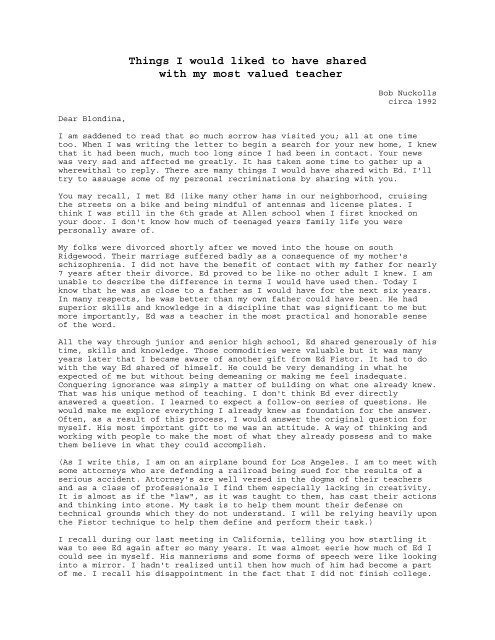
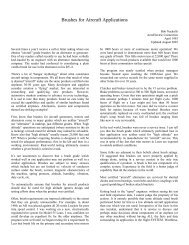
![G-Series-Ext [pdf] - Carling Technologies](https://img.yumpu.com/50918301/1/190x245/g-series-ext-pdf-carling-technologies.jpg?quality=85)
